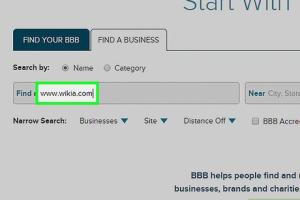10 Easy Ways to Verify Website Legitimacy for Safe Browsing

-
Quick Links:
- Understanding Website Legitimacy
- Why Check Website Legitimacy?
- Common Signs of Legitimate Websites
- Tools to Verify Website Legitimacy
- Step-by-Step Guide to Check Legitimacy
- Case Studies and Real-World Examples
- Expert Insights on Website Safety
- Statistical Data on Online Scams
- Conclusion
- FAQs
Understanding Website Legitimacy
In the digital world, where information is abundant yet unverifiable, understanding website legitimacy is crucial. A legitimate website is one that is trusted and recognized by users and regulatory authorities alike. It not only provides accurate information but also protects user data and privacy. With the increase in online scams, phishing, and fraudulent sites, knowing how to verify a website's legitimacy has become more important than ever.
Why Check Website Legitimacy?
Checking the legitimacy of a website helps you avoid:
- Phishing scams that steal personal information.
- Malware infections that can compromise your device.
- Financial scams that lead to loss of money.
- Identity theft that can affect your credit score.
Common Signs of Legitimate Websites
Before diving into tools and methods for verification, let’s explore some common signs that indicate a website's legitimacy:
- SSL Certificate: Look for "https://" in the URL, indicating a secure connection.
- Contact Information: Legitimate websites provide clear contact details, including a physical address.
- Professional Design: A well-designed website often indicates a serious business.
- Customer Reviews: Positive reviews on independent sites can validate a business's reputation.
- Privacy Policy: Legitimate websites have a clear privacy policy outlining data handling practices.
Tools to Verify Website Legitimacy
Numerous online tools can help you verify the legitimacy of a website:
- ScamAdviser - Analyzes the trust rating of a website based on various factors.
- VirusTotal - Checks for malware and safety issues on URLs.
- WHOIS Lookup - Provides information about the website's domain registration.
- Google Safe Browsing - Helps check if a website is safe to visit.
Step-by-Step Guide to Check Legitimacy
Here’s a detailed guide to help you check if a website is legitimate:
- Check the URL: Ensure it starts with "https://" and looks professional.
- Verify the Domain: Use WHOIS lookup to check domain registration details.
- Look for Contact Information: Ensure there’s a valid address, phone number, and email.
- Search for Reviews: Look for reviews on platforms like Trustpilot or SiteJabber.
- Use Verification Tools: Utilize tools like ScamAdviser and VirusTotal.
- Check for Social Media Presence: Legitimate businesses often have active social media accounts.
- Examine the Content: Look for typos, grammatical errors, and overall quality of content.
- Trust Your Instincts: If something feels off, it’s better to stay cautious.
Case Studies and Real-World Examples
To illustrate the importance of verifying website legitimacy, consider these case studies:
- Case Study 1: A consumer was scammed by an online store that mimicked a well-known brand. They lost $500 before realizing the site was fake.
- Case Study 2: A small business saved itself from a phishing attack by using WHOIS lookup and confirming the sender's legitimacy.
Expert Insights on Website Safety
Experts in cybersecurity recommend regularly checking website legitimacy, especially when sharing personal information. Dr. Jane Doe, a cybersecurity analyst, states, "Regularly monitoring the websites you interact with can significantly reduce your risk of falling victim to online scams."
Statistical Data on Online Scams
According to the Federal Trade Commission (FTC), online scams resulted in losses of over $1.9 billion in 2022 alone. This emphasizes the importance of verifying websites before engaging with them.
Conclusion
In a world where online scams are rampant, knowing how to verify the legitimacy of a website is essential. By following the steps outlined in this guide, utilizing online tools, and trusting your instincts, you can protect yourself from fraud and enjoy a safer online experience.
FAQs
1. What is a legitimate website?
A legitimate website provides accurate information, has proper security measures, and is trusted by users.
2. How can I tell if a website is secure?
Look for "https://" in the URL, check for an SSL certificate, and verify contact information.
3. Are online reviews reliable?
While many reviews are genuine, always cross-reference multiple sources for credibility.
4. What should I do if I suspect a website is a scam?
Do not provide any personal information, report the website, and consider using a website verification tool.
5. Can I trust websites with a professional design?
While design quality is a good indicator, it doesn’t guarantee legitimacy. Always verify further.
6. What is WHOIS lookup?
WHOIS lookup provides information about who registered a domain and when, helping assess credibility.
7. How often should I check website legitimacy?
It’s best to check each time you interact with a new site, especially before making purchases.
8. What are common signs of a scam website?
Signs include poor design, lack of contact information, and customer complaints on review sites.
9. Is it safe to use public Wi-Fi to browse websites?
Using public Wi-Fi can pose risks. Always ensure websites are secure and avoid sensitive transactions.
10. What should I do if I've fallen victim to an online scam?
Report the incident to your bank, the FTC, and consider monitoring your identity for potential theft.
Random Reads
- Hanging drywall beginners
- Hard reset vs factory reset
- How to look at minecraft screenshots
- How to log out of yahoo mail
- 7 ways to transfer files to ipad
- How to use image as windows icon
- How to unclog dishwasher
- How to unclog a drain
- 4 easy steps to make a gradient in gimp
- How to fix unrecognized usb disk